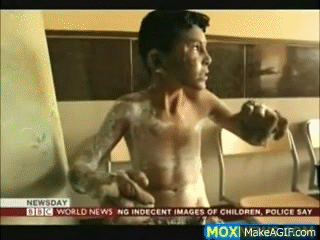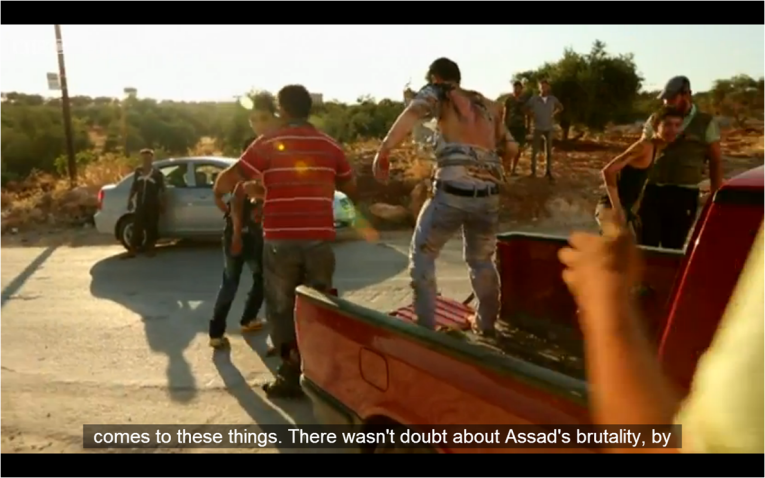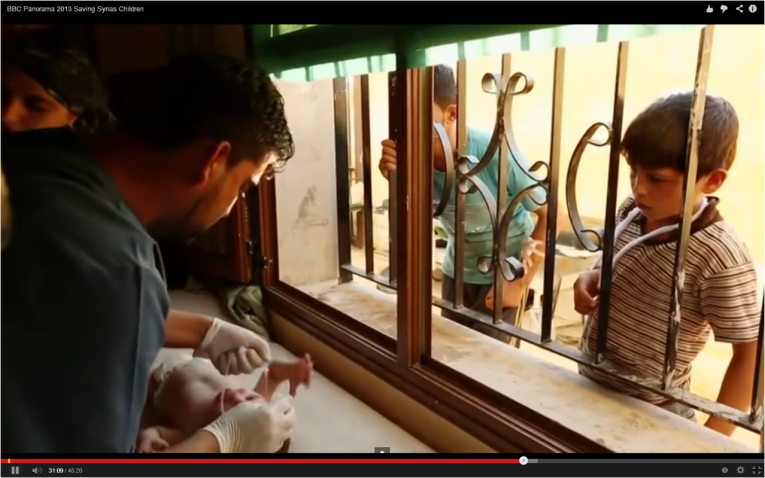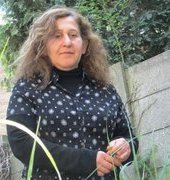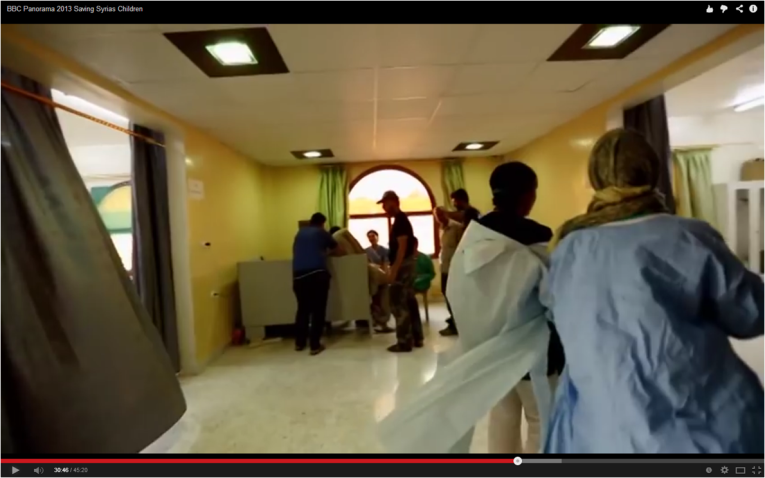The BBC “Saving Syria’s Children” Documentary: Staged Events, Fake Video Footage
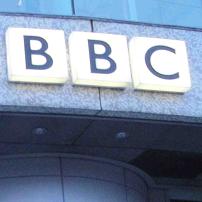
Analysis of the 30 September 2013 BBC Panorama documentary ‘Saving Syria’s Children’ and related BBC News reports, contending that sequences filmed by BBC staff and others at Atareb Hospital, Aleppo on 26 August 2013 purporting to show the aftermath of an incendiary bomb attack on a school in Urm Al-Kubra are largely, if not entirely, staged.
Introduction
On 29 August 2013, as the UK House of Commons vote on possible military intervention in Syria was underway [1], BBC News at Ten broadcast a report by Ian Pannell and cameraman Darren Conway which claimed that a Syrian fighter jet had dropped an incendiary bomb containing a “napalm-type” substance – possibly thermite – on the playground of an Aleppo school.
The report contained harrowing scenes of teenage boys and young men, their skin apparently in tatters, racing into what the report describes as “a basic hospital funded by handouts” to be treated for burns. In one particularly disturbing scene a tableau of young men writhe, drool and groan, seemingly in great distress.
Syria crisis: Incendiary bomb victims ‘like the walking dead’
– Ten O’Clock News, BBC One, 29 August 2013 (03:02 – 03:19)
Alleged victim Ahmed Darwish appears to await instruction
before turning to address the camera
On further viewings, however, this scene in particular is strikingly odd. The young men are initially quiet and static. The central figure (Mohammed Asi) looks directly into the camera for several moments before raising his arm, at which point the group instantly becomes animated and starts moaning in unison.
Asi begins to stagger and lurch; the boy in the black vest suddenly pitches onto his side, briefly looking up again in the same direction as the others before ultimately slumping onto his front; the boy in red (Anas Said Ali) raises his head and peers quizzically around, while the boy in the white shirt rises effortlessly to his feet before pulling up a chair. [2] As the camera pulls back a boy in a yellow ‘Super-9’ t-shirt (Lutfi Arsi) rises from the floor, flailing his head and torso and rolling his eyes as a team of medics sweeps in. Some images from the sequence are reproduced below. [3]
This and other questionable elements in this brief report prompted my first letter to the BBC on 4 October 2013.
While I was completing this letter, on 30 September 2013, the BBC broadcast a follow-up news report shortly prior to the transmission of the Panorama special Saving Syria’s Children the same evening.
Comparing the 29 August and 30 September reports a discrepancy in the soundtrack was apparent. In the first, Dr Rola Hallam (her face covered by a mask) had referred to “napalm”, in the second she said “chemical weapon”. I commented on this in the PS to my letter. The audio editing was subsequently discussed by former UK ambassador and blogger Craig Murray here and here. [4]Speculation on this point has since been widespread (see for example this RT report). My own concern remains on the evidence of wider fabrication in the hospital scenes.
The BBC’s initial response of 2 December 2013 dealt largely with the editing of Dr Rola Hallam’s words. My correspondence with the BBC has continued. Some of the main points which have arisen are as follows.
Date and time of the alleged incident
Fuller details here.
According to the BBC’s reports the alleged attack took place on Monday 26 August 2013. [5] Accounts of the time of the alleged bombing span a range of six hours.
A Human Rights Watch report which the BBC cited in its correspondence with me states (p12) that the attack occurred “around midday”; the same HRW report links to a further report by the Violations Documentation Center in Syria – a regularly cited BBC source – which claims (p4) the attack took place at 2.00pm and quotes an activist who says he first heard rumours of a “chemical attack” at 3.00pm.
‘Saving Syria’s Children’ reporter Ian Pannell has categorically stated that the attack happened “at around 5.30pm at the end of the school day”. Notably, this is contradicted by Pannell’s sole BBC colleague on the programme, its cameraman, director and producer Darren Conway, who has indicated that the alleged victims he filmed at Atareb hospital – some miles from the location of the attack – began arriving “between three and five”. Video of the Frontline Club event at which this contradiction arose remains unpublished: the Frontline’s justification for this change in its usual policy appears unpersuasive.
Another alleged eyewitness claims the attack may have occurred as late as 6pm.

‘Saving Syria’s Children’ cameraman, director and producer Darren Conway at the Frontline club on 15 October 2014, responding to a question about the time of the alleged 26 August 2013 “playground napalm bomb”: “It was the end of the day, yeah, I mean I don’t remember the exact time… …I would say it was around, I don’t know, between three and five, something like that.” (Footage filmed privately http://1drv.ms/1DfBr2T). Conway is speaking from his perspective as having been present at Atareb Hospital as the alleged victims arrived; Conway’s sole BBC colleague on “Saving Syria’s Children”, reporter Ian Pannell, has categorically stated that the alleged attack on the school in Urm Al-Kubra – some miles away from Atareb – occurred “at around 5.30pm at the end of the school day”. See http://bit.ly/1A1x62B.
The Demotix photographs
Fuller details here.
A series of eighteen photographs showing two alleged victims originally appeared on the photo journalism website Demotix dated 25 August 2013. Demotix later amended the date of the photographs to 26 August. When the images were dated 25 August, Ian Pannell denied that they featured victims from his report [6]; after the date had been changed, the BBC acknowledged thatthey did.
Conflicting accounts of first victims
At 31 minutes in Saving Syria’s Children Dr Saleyha Ahsan is shown attending to the first alleged victim – a baby, accompanied by his father. Ian Pannell’s narration at this point states “no-one’s quite sure what’s happened.” Only subsequently do the “dozens” of other alleged victims begin to arrive. This sequence of events is portrayed in several other accounts, including others given by Dr Ahsan.
However in an interview with Australian broadcaster ABC on 27 November 2013 Dr Ahsan gives an entirely contradictory account (from 02:38):
“It was quite a quiet day and I was beginning to hink ‘ooh gosh I’ve really got my timing wrong ‘cause what’s the point in me being here if I’m not going to be helping out?’ and then suddenly, standing to my left I just saw this rather strange vision I ju… I I felt as if I was having an out of body experience because I couldn’t quite work out what I was seeing, there was a boy, covered in this strange white dust, had wide staring eyes, his clothes were hanging off him, and he had this huge laceration on the side of his face, and his skin looked like it had areas of burn, and he was saying in a very calm voice ‘where shall I go okhty?’ which means sister in Arabic…”
In this version, the baby and his father do not feature at all. Instead Dr Ahsan states “it was quite a quiet day” prior to the arrival of the person she now claims was the first victim – a boy covered in “strange white dust”, who had a “huge laceration on the side of his face” and who spoke to her, asking her where he should go. This clear and vivid account is entirely irreconcilable with what viewers saw in ‘Saving Syria’s Children’.
On the website of the charity The Phoenix Foundation, launched in January 2015, Dr Ahsan writes:
The sound of an ambulance siren and then the screams first of all from a baby and then young girls – that I still hear as I write this – alerted me that something disastrous had happened.
Previous accounts make no mention of an ambulance siren heralding the baby’s arrival (including, most notably, Dr Ahsan’s “quiet day” ABC interview). Moreover, the reference to the screams of “young girls” immediately following those of the baby appears to contradict ‘Saving Syria’s Children’, in which the first alleged victims to arrive after the baby are adolescent males. In fact only one young female alleged victim (Siham Kanbari) appears in the entire Atareb hospital sequence. [7] [8]
A further complaint (see here and here) regarding apparent breaches of the Geneva Convention by Dr Ahsan in Libya in 2011 has been lodged with the BBC and copied to Amnesty International’s Libya Team.
Grinning victim
This information was submitted to the BBC by email on 5 November 2014. Fuller details here.
The image below is from a sequence originally transmitted in the BBC News report of 29 August 2013. [9] The slim boy in the black vest at the right of the picture, allegedly the victim of a “napalm-type substance”, is looking into the camera and grinning broadly.
The same boy appears at 31:56 in Saving Syria’s Children, apparently moments later, running into the hospital with his jeans lowered and again at 35:15 exclaiming “cover me” while allegedly being treated for his injuries by Dr Saleyha Ahsan. (See further images here).
If this boy’s injuries are not genuine then presumably those of the others arriving in the pick up truck with him – at least – are also fabricated. These include Mohammed Asi, of whom Ian Pannell has provided this image purporting to show him “two weeks after the attack in hospital in Turkey” and Anas Said Ali, whom the BBC claims died “a few days later in hospital in Turkey”. [10]
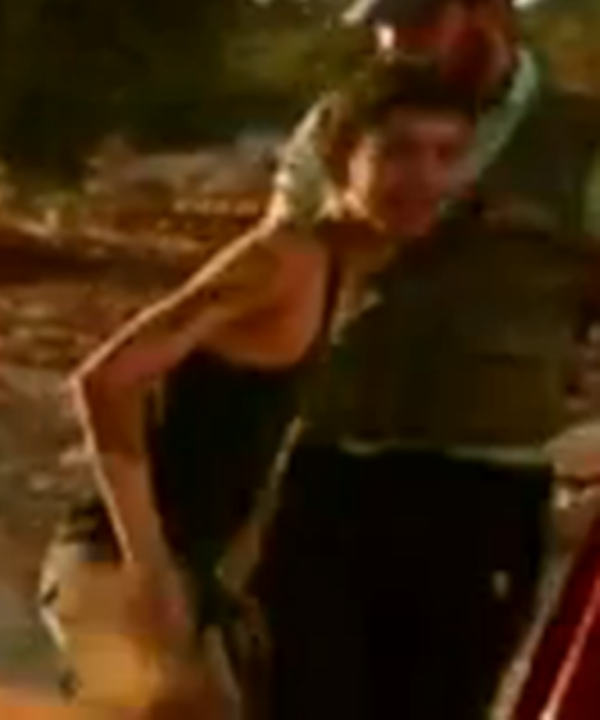
Alleged injuries of baby and his father
Fuller details here.
The baby featured from 31 minutes in ‘Saving Syria’s Children’ does not appear to have suffered “severe burns” as claimed in the narration, and certainly not the 80% burns (elsewhere “full-body burns”) claimed by Dr Hallam which, as the high percentage indicates, would cover the majority of the infant’s body. Rather, he appears unscathed and in no unusual degree of distress (click images below to enlarge).

At 31:18 Dr Ahsan’s advises “this baby needs to be picked up” and the child is robustly handled by Dr Ahan and the supposed father. If the baby had suffered severe burns covering up to 80% of his body this would appear extremely inappropriate and reckless.
Subsequent accounts of the infant’s injuries range from “nasty scolds [sic] on his legs” (Dr Ahsan) to Dr Hallam’s “80%”or “full-body” burns.
A BBC News article by Ian Pannell states that the baby’s father “was also burnt and sat helplessly on a stretcher clutching his son”. Dr Hallam states here (from 22:17) that the infant’s father “also had a burnt face” and here that he “had head burns”. However the supposed father (seen over Dr Ahsan’s left shoulder at 31:16 and again holding the baby at 31:31) is animated, vocal and appears unscathed. [11]
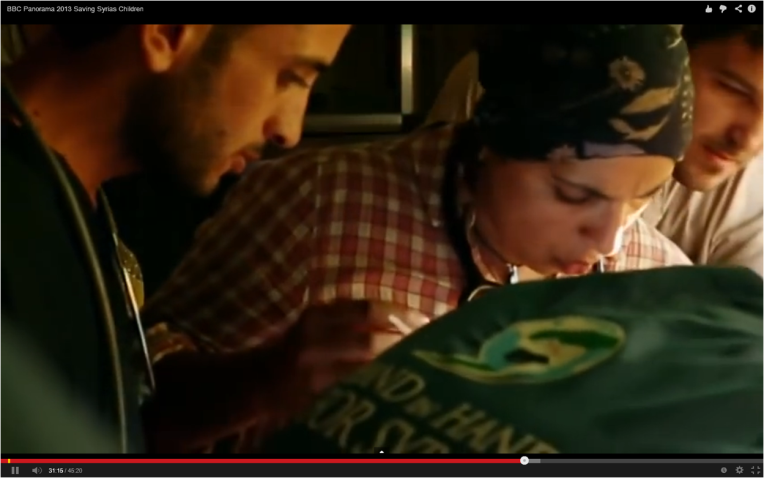
The baby’s alleged father (right), who according to Dr Hallam “also had a burnt face” http://bit.ly/1zcKgI3
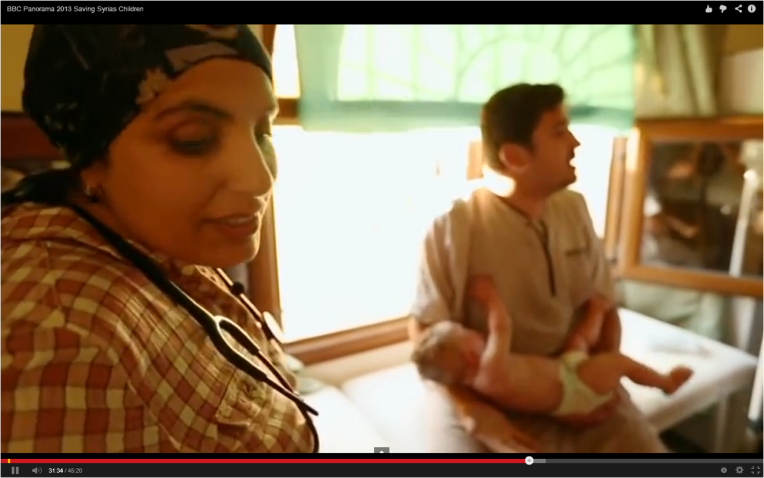
The baby’s alleged father, speaking and gesturing animatedly to someone off-screen.
According to Ian Pannell he “was also burnt and sat helplessly on a stretcher clutching his son”
Plausibility of injuries and demeanour of alleged victims
A practicing doctor has offered this opinion of the alleged injuries presented in ‘Saving Syria’s Children’:
I have watched the panorama BBC documentary. Makes for interesting viewing but I think the scene of the school children coming in with the burns was an act.
I worked on trauma and orthopaedics last year for four months, so I have worked with burns victims first hand. These victims displayed what appeared to be “less painful” burns. They were able to sit down, be touched by others even talk. This is not how a severe burn victim would present. Most victims:
- would be screaming the place down in agony. Even after treatment and with all sorts of pain drugs they still hurt and still scream.
- Many burns victims cannot even focus enough to follow instructions such as sit down and wait because of pain. This young boy, I found very odd (I don’t think it is cultural thing as pain is pain and it can drive a person mad).
- would have difficulties with their airways, almost immidiatley, hence in the UK many are intubated and treated in ITU. This shows them able to speak and breathing very well no obvious signs of respiratory distress like coughing, shallow breathing etc. In such an attack the poisons are inhaled.
- They say they douse them in water (wouldn’t the high spray of the hose cause more problems to burnt skin).
- when they came to the hospital they have evidence of this white powder on their skin but not evident burn blisters which fill with fluid with in minutes. Some are shown with skin hanging off but the flesh beneath is not that convincing it actually looks like more skin.
- The walk is very odd. why??
- The other concern in burns is their fluid status as they will be losing large amounts of fluid through their burns. The cannula is essential to resuscitate them. Im not sure what A and E that doctor worked in but I have not worked in A and e this year and I have placed I think almost 6 cannulas in peoples feet. [12]Any access is essential in burns, a standard training skill!
- If the poison was dropped from above (a plane) their hair would have been lost and patches would be evident. Many still had a full heads.
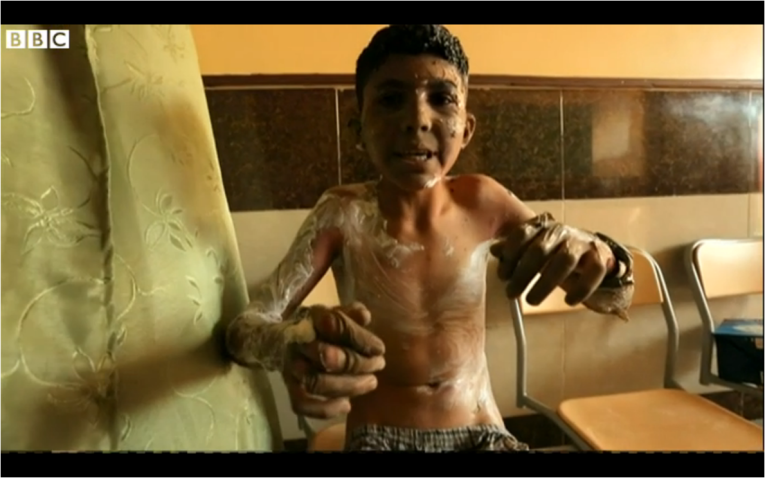
Alleged victim Ahmed Darwish http://bit.ly/1KGzVeK (click to enlarge)
Ahmed Darwish appears to await instruction before turning to address the camera
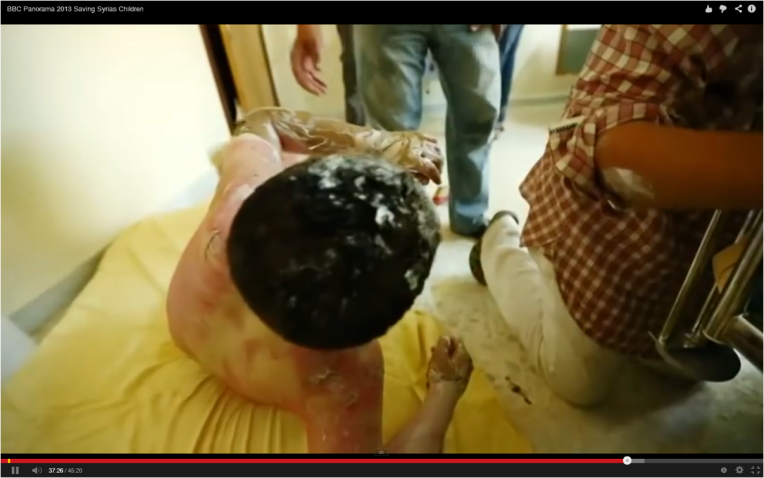
Alleged victim Lutfi Arsi http://bit.ly/1FiYu3k. A doctor comments:
“Some are shown with skin hanging off but the flesh beneath is not that convincing it actually looks like more skin” (click to enlarge)
The doctor’s opinion is congruent with that of former UK ambassador Craig Murray who, in a 31 March 2014 email regarding the nomination of Ian Pannell and the “Chemical School Attack” report for One World Media awards, wrote: “having personally been in my career in rather similar conflict situations, I was struck by the strange absence of panic and screaming both by patients and surrounding family – I have seen people in that sort of pain and situation and they are not that quiet and stoic, in any culture.”
Most of the alleged victims presented in ‘Saving Syria’s Children’ are notably calm and quiet. Some mill around in the hospital and its yard.
- From 33:05 – 33:46 Lutfi Arsi (in the yellow ‘Super 9’ t-shirt) calmly inspects his fellow alleged victims, helpfully directs a member of staff towards them, ambles to the back of the room, pulls up a chair and takes a seat.
- In the same sequence note the exaggerated swaying and lurching of the man in the white t-shirt at the back of the room; identifiable by the three black marks on his t-shirt, this is the supposed teacher who some time later (judging by the addition of bandages to his arm) provides a relaxed and cogent interview, partially translated here. (See images immediately below) [13]
- At 36:52 Anas Said Ali speaks, incongruously, in English (“I’m so bad, so bad”) .
- At 38:13, allegedly suffering 86% burns, Lutfi Arsi sits up to peer inquisitively at the camera.
Compare the demeanour of these alleged victims with footage of napalm bombing survivor Kim Phuc.
The “victims” presented in ‘Saving Syria’s Children’ appear to have retained their eyebrows, despite white cream suggesting treatment for facial burns. Note in particular the undamaged eyebrows of the alleged teacher and those of Siham Kanbari “a few weeks after the attacks in hospital”.
In her decision of 26 September 2014 the BBC Senior Editorial Complaints Adviser cites the opinion of a “consultant plastic surgeon with training and experience in the presentation, prognosis and outcome of traumatic burns injuries”. This opinion does not take into account the possible use of medical simulation techniques such as HOSPEX, discussed immediately below.
More (non-BBC) footage of the alleged victims presented in ‘Saving Syria’s Children’ is on the “Free Halab” blog.
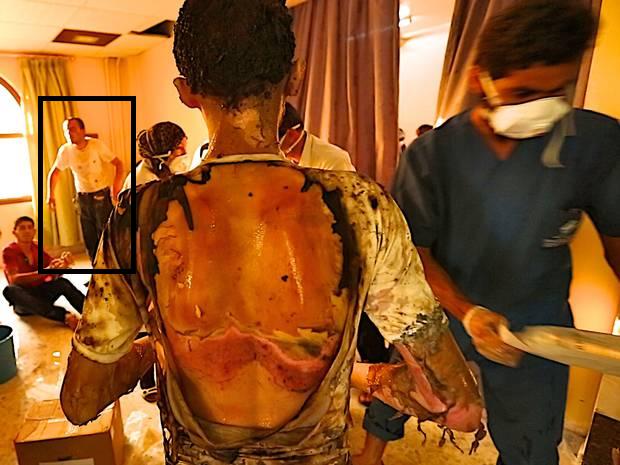
Alleged teacher (white t-shirt with black marks) swaying and lurching from 33:38 to 33:46
in Panorama prior to giving relaxed and cogent interview below.http://bit.ly/1FcaK3Q

Alleged teacher interviewed here http://youtu.be/za_PByVBkJ4?t=40s. Black marks on t-shirt identify him
as the swaying figure seen from 33:38 to 33:46 in Panorama (above)
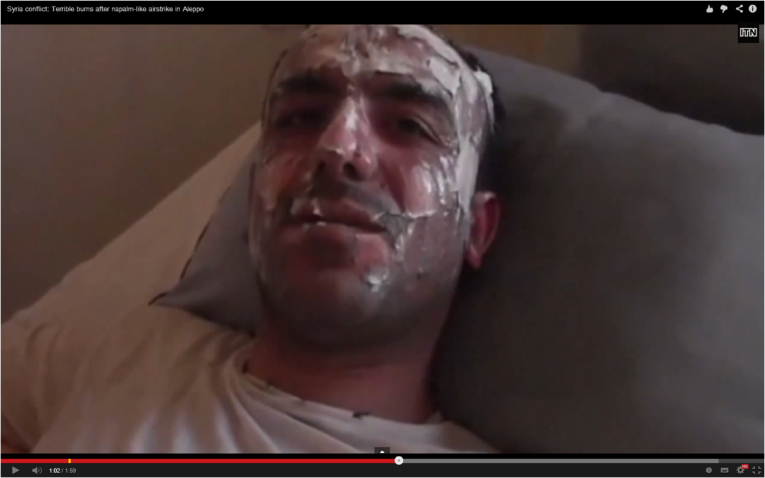
Alleged teacher. Note undamaged eyebrows.
HOSPEX medical simulation techniques
Fuller details here.
In a BBC Newsnight report of 11 August 2014 Dr Saleyha Ahsan, one of the two British doctors featured in ‘Saving Syria’s Children’, described “how British Army medical services prepare for deployment using HOSPEX” (Hospital Exercises), a “macro-simulation replicating exactly the conditions medics will face in the field”. Dr Ahsan states:
“The principle behind ‘macro simulation’ is that it’s as close to reality as possible. Actors and make-up artists mimic even the most severe of injuries”.
The level of expertise in fabricating injuries and emergency situations demonstrated in this report would appear to be more than adequate to account for the hospital scenes in Saving Syria’s Children. In the report Dr Ahsan states that the officer in charge of the operation, Brigadier Kevin Beaton, was her squadron commander in Bosnia and inspired her to study medicine.
Compare the first image below, featuring a “simulated burns casualty played by a professional actor” and published in an article about the Army Medical Services Training Centre (AMSTC) near York, where HOSPEX exercises are held, with the subsequent image of Victim X from the BBC Ten O’Clock News report of 29 August 2013:

Above: image and caption from 2008 Army Medic article about the AMSTC facility near York
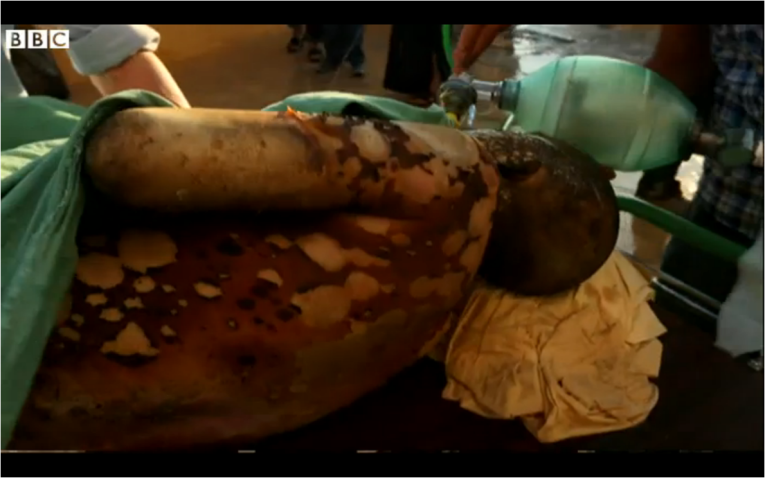
‘Victim X’ from BBC Ten O’Clock News 29 August 2013
As noted below, it may be significant that Atareb hospital staff were attending a battle first aid training course in Turkey on the date of the alleged napalm bomb attack.
Identity of western male filmed at Atareb hospital
A western male in a grey shirt and spectacles appears at 2:06 in the BBC News report of 30 September 2013. He is carrying a camera and demonstrates concern that the BBC’s interview with Dr Rola Hallam is recorded without interruption, extending his arm to prevent others getting into shot.
The presence of this person is perplexing, as at no point in its correspondence has the BBC suggested that the Panorama crew in Syria at that time consisted of anyone other than reporter Ian Pannell, cameraman/producer Darren Conway and fixer/translator Mughira Al Sharif, plus presumably local drivers/minders.
In an appeal review request of 28 December 2014 another complainant directly asked the BBC to identify the man in the images below. In its rejection of this request the BBC Trust’s Editorial Standards Committee ignored this question, along with several other potentially significant points.
Update: The editor of Panorama ‘Saving Syria’s Children’, Tom Giles, has commented here.
Women wearing identical clothes
Fuller details here.
A woman wearing a black dress with a distinctive gold design rushes throughAtareb hospital gates at around 36 minutes in ‘Saving Syria’s Children’ with a man claiming to be her father (they appear of similar age).
In other footage from Atareb, shot after nightfall, a younger woman is seen wearing an identical dress and blue headscarf. This woman claims that she and other alleged victims are students in “Orm Alkubra academy”, all of whom are under 18 (transcript here). A medic in the video observes that, while the majority of alleged victims required transfer to other hospitals, the young woman, with only 20% burns, was “among the lucky ones”. [14] [15]
It is abundantly plain that the two women are separate individuals: not only is the age difference readily apparent, the younger woman in the non-BBC footage explicitly states that she is a student under the age of 18, while the woman who features in Panorama is entirely implausible in this role. Further, Dr Saleyha Ahsan has stated that the woman seen in Panorama (in daylight) was waiting to be evacuated to a Turkish or border hospital, whereas the medic in the non-BBC footage (shot after dark) explicitly states that this was not necessary in the case of the younger woman.
The question arises as to why these two different women should apparently have shared the same clothing.
On 8 August 2014 BBC Senior Editorial Strategy Adviser Natalie Rosestated (p16) that the two women were “clearly the same individual”.
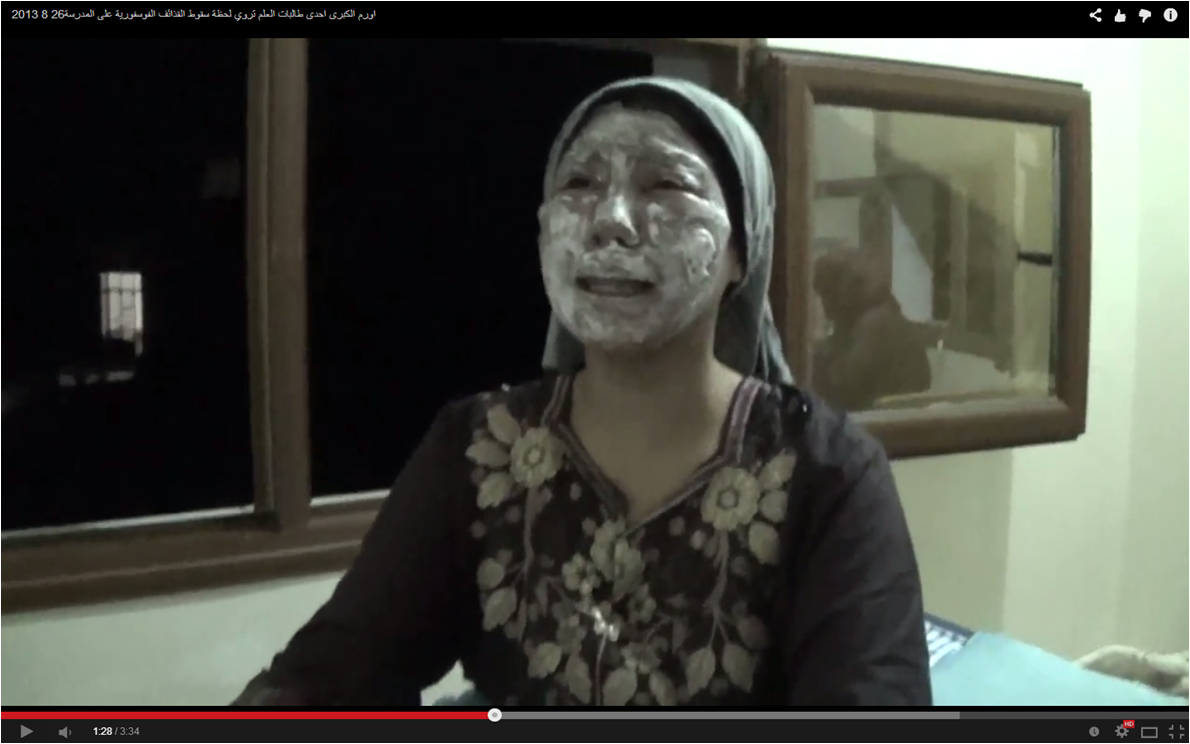

FSA commander attests attack did not take place
This information was submitted to the BBC on 13 October 2014.
A team of Syrian investigators which has been researching the alleged attack has been in contact with a former commander of the Al-Tawhid Brigade who was based in Aleppo province in August 2013 and who was in close contact with events in Urm Al-Kubra. The team has provided me with the commander’s name.
The commander attests that the “napalm bomb” story is untrue and that none of the events depicted by the BBC occurred. He has provided this brief declaration (his voice is disguised) which the lead investigator has transcribed as follows:
In the name of God the most gracious the most merciful.
We the fighters of the Free Syrian Army in the North West areas of the City of Aleppo we declare that we were present in this region in August 2013 and we did not meet any air strike with the substance of Napalm on Urum al Kubra or on any other region in the North West Aleppo countryside and we deny the cheap fabrication of the BBC and of the stations that imitate her because it undermine the credibility of the Free Syrian Army. Saying this we do not hesitate to criminalize the criminal acts of the Assad regime and its murderous extermination of its people. And we have done a field investigation with the help of the delegate of the Free Syrian Red Crescent and this has conducted us to confirm what we are saying : no victims, no traces and no memory with anybody of the alleged air strikes with the substance of Napalm. And may peace be upon you and the mercy of God and His blessings.
The commander has agreed to provide a full statement to the BBC providing that his identity is protected. He is also willing to testify publicly under appropriate international protections. The commander, who is now attached to another faction allied to the Free Syrian Army, has offered to provide BBC journalists with safe transit from Antakya, Turkey to Urm Al-Kubra to interview witnesses assembled by the Syrian team and to conduct their own investigation.
A July 2014 telephone conversation between two members of the Syrian investigative team, transcribed here, provides an account from another local resident who also affirms that the alleged napalm bomb attack did not occur.
Identification of participant in hospital footage
Fuller details here. This information was submitted to the BBC on 2 September 2014and 13 October 2014.
A 51 year old Dutch-Armenian woman (first two images below) contacted me through Facebook in June 2014 to request that I remove a screengrab from ‘Saving Syria’s Children’ which I had posted on the site, claiming that she was in it and that she did not wish others to see it.
Although the woman was not featured in the particular image I had posted, I interpreted her words as possibly meaning she had been photographed or filmed at Atareb hospital on 26 August 2013, the day of the alleged attack. The woman did not respond to my requests for clarification.
Some weeks later I came across this video shot at Atareb hospital on 26 August 2013 in which at 20:36 a woman is briefly seen having white cream applied to her face and hands (third image below). The resemblance between this person and the woman who contacted me is extremely striking and they would indeed appear to be one and the same.
The woman’s Facebook page demonstrates that she has previously travelled between Syria and the Netherlands, where she resides. There is a gap in her Facebook posts in the weeks around 26 August 2013.
Dr Rola Hallam and Hand in Hand for Syria
Dr Rola Hallam, who features throughout Saving Syria’s Children, is described as “a British doctor visiting for the charity Hand in Hand for Syria”.

Dr Rola Hallam in ‘Saving Syria’s Children’
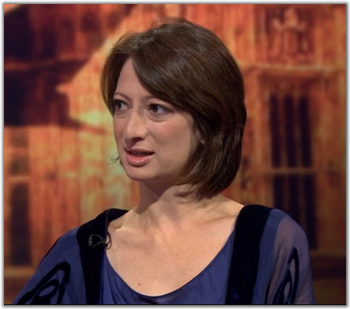
Dr Rola Hallam, Newsnight, BBC2, 30 August 2013
(‘Syria crisis: Doctor criticises Miliband over MPs’ vote’
http://www.bbc.co.uk/news/uk-politics-23909554)
On 30 August 2013, the day after the first BBC report on the alleged attack, Dr Hallam appeared on Newsnight expressing her disappointment at parliament’s rejection of a military strike against Syria.
Dr Hallam’s father is Dr. Mousa al-Kurdi. [16] According to a February 2013article written Dr Hallam’s colleague, Dr Saleyha Ahsan, Dr al-Kurdi is “involved politically with the Syrian National Council”. In an Al Jazeera interview Dr al-Kurdi proclaims the Syrian National Council to be the “representative of all Syrians” and relates how, following his address to the Friends of Syria summit in Istanbul in 2012 (attended by Hillary Clinton), he told Turkish Foreign Minister Ahmet Davutoğlu “You’re not doing enough” and demanded of Professor Davutoğlu and several other foreign ministers, including Victoria Nuland of the US State Department, “either you defend us or you arm the Syrian Free Army to defend us – you have the choice”.
At a Save the Children event in November 2013 Dr Hallam stated that her father “is certainly not a member of the Syrian National Council; he is a gynaecologist, who like most Syrians has taken an interest in what’s happening in his country”.
Dr Hallam is a member of the charity Hand in Hand for Syria’s executive team. Hand in Hand’s original three-star logo is plainly based on the flag adopted by the Free Syrian Army and the Syrian National Council. In 2014 the charity removed the stars from its logo.
Until July 2014 the Facebook banner of Hand in Hand’s co-founder, Faddy Sahloul, read WE WILL BRING ASSAD TO JUSTICE; NO MATTER WHAT LIVES IT TAKES, NO MATTER HOW MUCH CATASTROPHE IT MAKES. The image was removed shortly after this comment on an article in The Guardian newspaper was made.
Further questions about the financial affairs and political affiliations of Hand in Hand for Syria have been raised by Dr Declan Hayes of the University of Southampton in a 436 page dossier and here. Dr Hayes’ research has been submitted to the police and the Charity Commission. This video also asks questions about Hand in Hand for Syria’s ethics and motivations.
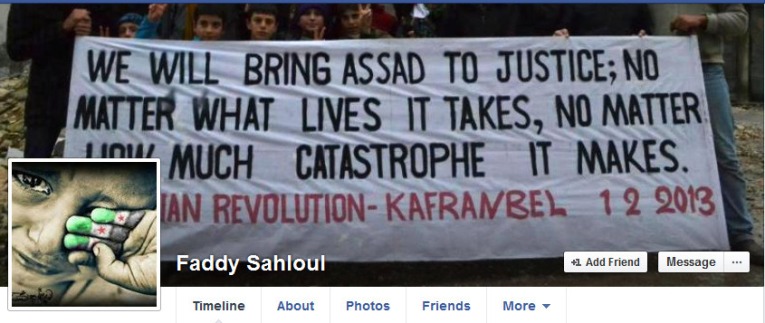
The Facebook banner of Hand in Hand for Syria founder Faddy Sahloul, deleted July 2014

Original logo of Hand in Hand for Syria bearing the three stars of the Free Syrian Army/Syrian National Council flag
Dr Hallam (white mask and green scarf) strolls unhurriedly upstairs at Atareb Hospital on
26 August 2013 in the midst of what she later described as a “mass casualty event“ in
the first five seconds of this video, one of those collected on the Free Halab blog.
Atareb: “a basic hospital funded by handouts”
In June 2014 Hand in Hand for Syria launched a fundraising campaign which identified the hospital featured in ‘Saving Syria’s Children’ as Atareb Hospital, Aleppo.
A campaign page dated 10 June 2014 (since deleted) on Hand in Hand for Syria’s website stated that Atareb Hospital opened in May 2013 as a small A&E unit and that (my italics):
“The hospital’s funding comes from a European donor which supports global emergency response. This funding reaches Hand in Hand for Syria via an INGO partner. Although that funding is still very much in place, after one year our agreement with our INGO partner has come to an end – and the funding has to come through a partner.”
This makes clear that funding for Atareb Hospital – “from a European donor”, “via an INGO partner” – was secured prior to Ian Pannell’s description (03:17) of it as “a basic hospital funded by handouts”. [17] Indeed, images on the Atareb Facebook page posted before 26 August 2013, the day of the “napalm bomb”, depict a relatively well-equipped facility, including a kidney dialysis machine and surgical and x-ray facilities. (Please note there are some highly distressing images on the Atareb Facebook page).
The campaign page states that Atareb “now offers 68 beds and a wide range of services – from maternity and neo-natal facilities to many outpatient departments, three excellent operating theatres and a laboratory”. Elsewhere, Atareb is described as “One of the country’s most sophisticated remaining hospitals” with operating costs, according to Dr Hallam, of “between $60,000 and $70,000 a month”. Atareb’s current facilities are further indicated in the campaign materials.
The Syrian team investigating the alleged attack has produced this report which provides further information on the connections between Hand in Hand for Syria and Atareb Hospital, which the report claims “is facing very serious problems of administration, honesty, transparency and professionalism.” [18]
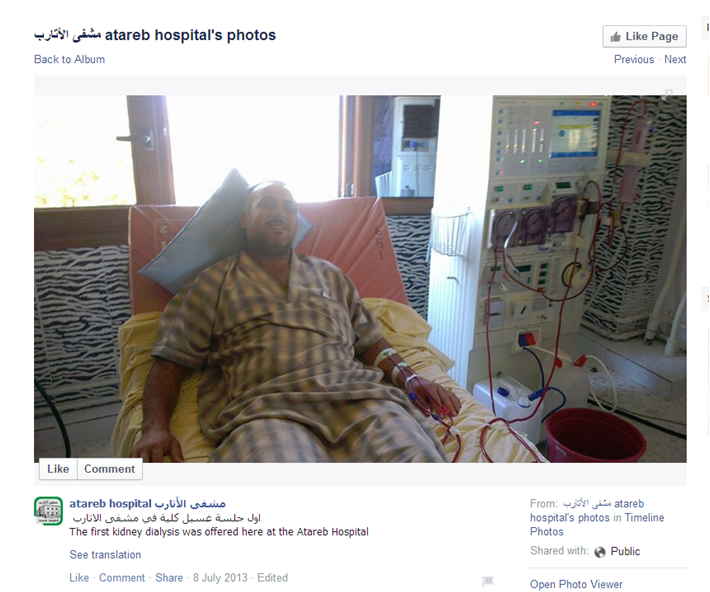
Post on Atareb Hospital’s Facebook page showing a new dialysis machine in use over one month prior to Ian Pannell’s description of Atareb as “a basic hospital funded by handouts”.
Regular Atareb Hospital staff absent on day of alleged attack
A post on Atareb Hospital’s Facebook page shows that on 26 August 2013, the date of the alleged attack, hospital staff were “attending a battle first aid training course in Antakia, Turkey”. This may indicate that some of the medics filmed by the Panorama team were not regular Atareb staff members.
Violations Documentation Center in Syria
A report by the Violations Documentation Center in Syria (a regularly cited BBC source) links to a list of 41 alleged victims of the attack. Several of the names are identifiable as those ascribed to individuals featured in ‘Saving Syria’s Children’, however their date of death in all cases is given as 26 August 2013.
While this reflects the Panorama account in respect of Lutfi Arsi (Loutfee Asee on the list), whom the BBC claims “died on his way to hospital in Turkey”, it contradicts it in respect of Anas Sayyed Ali (Anas al-Sayed Ali), whom the BBCclaims “died a few days later in hospital in Turkey” and whom Dr Ahsanstates (p15) died “two weeks later”; Ahmed Darwish (Ahmad Darwish), who was filmed by Panorama “a few weeks after the attack in hospital in Turkey”; Siham Kanbari (Siham Qandaree), also filmed later in the same hospital and whom Dr Ahsan has stated died on 20 October [19]; and Mohammed Asi (Muhammad Assi) who is pictured in an image provided by BBC Audience Services “two weeks after the attack in hospital in Turkey”.
The list omits Mohammed Kenas who according to Panorama “died on the way to hospital in Turkey”. [20]
The list includes a Muhammad Abdullatif, age 15. Mohammed Abdullatif is the name of the adult eyewitness who appears in the 29 August 2013 BBC News report (02:54) and in this non-BBC footage of the same “interview”.
Videos on the ‘Free Halab’ blog
The collection of videos of the alleged events of 26 August 2013 assembled by the “Free Halab” blog poses further questions as to the veracity of the BBC’s account.
For example, the opposition fighter speaking in this film [21] shot at Atareb Hospital on the day of the alleged incident, refers to “seven martyrs and about 50 wounded from the religious college for women and girls”. [22] This contradicts the BBC’s account in which the majority of student victims are seen to be adolescent males. [23]

This fighter in a video from Atareb Hospital on the day of the alleged attack refers to “seven martyrs and about 50 wounded from the religious college for women and girls”. Most alleged victims filmed by the BBC are adolescent or older males. http://1drv.ms/1CvSEox
Misleading and manipulative editing
The hospital scenes in ‘Saving Syria’s Children’ and associated BBC News reports are extensively and misleadingly edited. Some examples are:
- At 02:08 in the 29 August 2013 BBC News report Mohammed Asi is shown climbing down from a truck, accompanied by Dr Ahsan’s words “more coming? More? More?” However Asi had already been shown walking into the hospital from 01:44.
- At 34:08 in ‘Saving Syria’s Children’ the narration states “within minutes the hospital is overwhelmed” over footage of Lutfi Arsi being carried into the hospital. However this is Arsi’s third appearance in the programme, having previously been seen at 32:26 and from 33:05 – 33:44.
- Victim X is shown arriving in the hospital yard at 35:35 in ‘Saving Syria’s Children’, heralded by Dr Ahsan’s words “I think there’s more coming, I think there’s more coming”, despite his having previously seen being “treated” inside the hospital from 34:36 – 34:55.
- A woman exclaims “yama yama yama” as she enters the hospital at 34:02; the same audio clip is also used over footage of Victim Y entering the hospital at 31:44.
On 23 April 2014 BBC Complaints Director Colin Tregear wrote:
…the programme-makers felt they were justified in using footage out of chronological order “to show the mayhem and the mood of what was happening around”. I am satisfied that the editing would not have affected the audience’s overall impression of what took place.
Victim who “fought to be allowed into hospital” had already been treated
In a contemporary BBC World Service report Ian Pannell states (at 3:06) “Fathers and mothers, desperate for help, fought to be allowed into the hospital, cursing their president Bashar al-Assad”.
However the cries and rants heard at this point are those of the alleged father and mother of the woman in the black dress seen at 2:37 in the BBC Ten O’Clock News report of 29 August 2013 (compare audio).
On 23 April 2014 the BBC explained (pp 6 & 7) that in this sequence the woman had already been treated inside the hospital with white burns cream. She then “went back outside” (to be evacuated to a Turkish or border hospital according to Dr Saleyha Ahsan) prior to rushing back through the hospital gate (at 36 minutes in Saving Syria’s Children) with her family to declaim Assad to the BBC camera.
To say that the family was at this point fighting “to be allowed into the hospital” is therefore false. Furthermore, none of the alleged victims in ‘Saving Syria’s Children’ are seen fighting “to be allowed into the hospital” – they are carried or walk inside, entirely unimpeded.
In his BBC web article of 30 September 2013 Pannell repeats the claim that “Fathers and mothers” “fought to be allowed into the hospital” but here substitutes the phrase “desperate for help” with “desperate for news”.
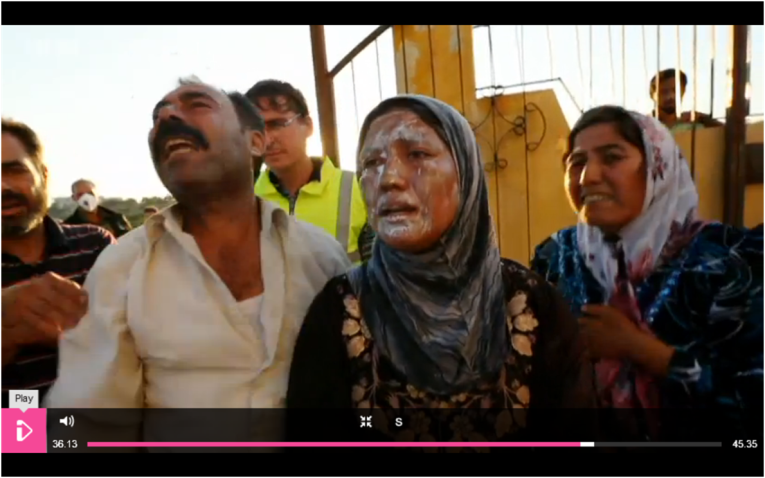
Ian Pannell claimed that here this family was fighting “to be allowed into the hospital”. The BBC later stated that the woman in the centre had already been treated. See http://bit.ly/16GapbZ
Bias and lack of analysis in ‘Saving Syria’s Children’
On 2 July 2014 Susan Dirgham, National Coordinator of Australians for Mussalaha (Reconciliation) in Syria, lodged a complaint about ‘Saving Syria’s Children’ invoking sections of the BBC Editorial Guidelines which relate to Accuracy, Impartiality, Fairness, Conflicts of Interest and Accountability. Ms Dirgham’s complaint was rejected by the BBC as untimely.
Mughira Al Sharif
Mughira Al Sharif is credited as “Fixer/Translator” on ‘Saving Syria’s Children’. He can be glimpsed at various points in the programme, most distinctly at the wheel of the car which takes Ian Pannell through an ISIS checkpoint (at 10:33).
A 2011 article tells how Sharif helped to found the Syrian Revolution Istanbul Committee and reports his aim as being “to help bring down the Syrian regime”.
Sharif’s Instagram site contains numerous images demonstrating his fervent support for armed opposition forces in Syria, including one in which he proudly bears the standard of the Idlib Martyrs Brigade. Several images jocosely celebrate the involvement of children in the conflict, with captions such as “the youngest revolutionary”. [24]
An image in which Sharif poses with “some friends” in the armed opposition was posted on Monday 26 August 2013, the day of the alleged napalm bomb attack. Notably, Sharif was clearly not so traumatised at witnessing dozens of allegedly injured and dying children and teenagers at Atarab hospital that he felt any qualms about posting another celebratory image of child fighters the next day.
Both Susan Dirgham in her letter to the BBC of 2 July 2014 and another complainant have argued that Al Sharif’s involvement in ‘Saving Syria’s Children’ breaches BBC Editorial Guidelines.
BBC Worldwide blocks You Tube copies of ‘Saving Syria’s Children’
Fuller details here, updates here and here.
At the start of July 2014 BBC Worldwide began blocking You Tube copies of ‘Saving Syria’s Children’, including the copy I had been linking to in mycorrespondence with the BBC and that referenced by Susan Dirgham in her complaint to the BBC.
I began substituting links in my blog to correspond with an alternative You Tube copy of the programme. On 20 July this too was blocked. (On 23 July it was removed by the channel owner). Notably, part one of a version originally shown on Australian television and which included excerpts from the hospital scenes was blocked sometime after 20 July, while part three – which features no Panorama footage – remains available. [25]
The final existing You Tube copy of ‘Saving Syria’s Children’ was blocked by BBC Worldwide between 25 and 28 July 2014. Dozens of other Panorama programmes remain freely available on the site.
The UK BBC iPlayer version of ‘Saving Syria’s Children’ expired on 30 September 2014 (17 October with BSL). This copy adheres to the timings in this blog and can be downloaded here. A somewhat higher quality copy is here.
On 1 August 2014 BBC Worldwide provided this response to questions about the You Tube blockings.

At least four full-length You Tube copies of ‘Saving Syria Children’ have been blocked by BBC Worldwide since the start of July 2014.
Substitution of footage – BBC Newsnight 29 August 2014
Fuller details here. Subsequent correspondence with the BBC here, here, here andhere.
This edition of BBC2’s Newsnight was devoted to the consequences of the UK Commons vote on intervention in Syria exactly one year previously. It included footage of the “napalm bomb” incident accompanied by the narration “by chance, just as MPs voted, these images of a chemical [sic] attack were shown for the first time”.
A subsequent broadcast on the BBC News Channel some hours later substituted the “napalm bomb” images with footage from an alleged chemical attack on Saraqeb, Northern Syria on 29 April 2013, originally broadcast in a BBC News report of 16 May 2013. The images were not identified and the substitution was not acknowledged. The narration continued to inform viewers that the substituted images had been “shown for the first time” on the evening of 29 August 2013.
This matter is now the subject of a separate complaint to the BBC. (Links to correspondence above).
Update July 2015: the BBC Editorial Complaints Unit has acknowledgedthat the substitution of footage represents a breach of BBC editorial standards for accuracy. Concerns about BBC editorial policy and practice raised by this matter remain to be pursued.
Breaches of Geneva Convention by Dr Saleyha Ahsan
A further complaint (see here and here) regarding apparent breaches of the Geneva Convention and other concerns regarding the ethics and integrity of Dr Saleyha Ahsan has been lodged with the BBC.
Original BBC reports
- Syria crisis: Incendiary bomb victims ‘like the walking dead’ – Ten O’Clock News, BBC One, 29 August 2013
- Syria crisis: Doctor criticises Miliband over MPs’ vote – Dr Rola Hallam, Newsnight, BBC2, 30 August 2013
- Syria: Agony of victims of ‘napalm-like’ school bombing – Ten O’Clock News, BBC One, 30 September 2013
- Panorama – Saving Syria’s Children – BBC One, 30 September 2013 (relevant section commences 30:38). BBC Worldwide has blocked all You Tube copies of ‘Saving Syria’s Children’. Please consider downloading this copy.
Other reports and commentary
Some of the analysis in these reports has been superceded. I do not agree with every interpretation contained in them.
- Fake BBC Video – Craig Murray, 7 October 2013
- The Theatre of War – Craig Murray, 8 October 2013
- Why was a BBC interview in Syria doctored? – Jonathan Cook, 7 October 2013
- Media hypocrisy and why I write – Jonathan Cook, 8 October 2013
- The Role of the BBC in the Syrian Conflict – “Rinnief”, You Tube, 3 November 2013
- The Truthseeker – Media ‘staged’ Syria Chem Attack – RT, 23 March 2014 Previous copy posted here removed March 2015 – please consider downloading. Lower quality version here, higher quality excerpt here.
- Inside the BBC’s Uprising: Hand in Hand for Propaganda – “Rinnief”, You Tube, 3 April 2014
- WANTED: Evidence Hand in Hand for Syria is Really in the Business of Saving Lives – “Rinnief”, You Tube, 10 April 2014
- BBC Propaganda – Craig Murray, 16 October 2014
Complaints correspondence with BBC
Correspondence between the BBC and myself (and latterly another complainant) is logged here.
Notes
[1] Hansard reports the two Commons votes on Syria on Thursday 29 August 2013: Division No. 69 (9:59pm) on the Labour amendment and Division No. 70 (10:17pm) on the government motion.
The Daily Telegraph’s live reporting of the day’s events notes between 22:15 and 22:30:
As MPs vote, the BBC is playing a report into a horrific incendiary weapon strike on a school near Alleppo. Many children have been badly burnt.
[2] In its initial response the BBC stated that that boy in the white shirt “appears relatively unscathed”. The same boy appears at 01:17 in this non-BBC video from the day, calmly walking downstairs accompanied by the caption “These are not performing actors”.
[3] Note that the left hand curtain at the back of the room has been pulled back from its previous position (see below and images 6 – 10 here).
[4] Craig Murray has more recently commented here.
[5] In an article for Foreign Policy Dr Saleyha Ahsan, one of the British doctors featured in Saving Syria’s Children, gave the date of the alleged attack as 27 August, a highly surprising error for a journalist to make, especially considering her statement that “out of all the war zones I have ever been to, today has been by far the worst”.
In a 3 October 2013 article Dr Ahsan wrote “This month, Dr. Hallam and I found ourselves in a school that had been hit by a napalm-like bomb”. This seems intended to suggest that Doctors Ahsan and Hallam were present at the school as it was allegedly being attacked, rather than at the hospital treating the alleged victims; “this month” is also odd as Dr Ahsan claims elsewhere to have visited the school two days after the attack, i.e. on Wednesday 28 August .
[6] The Demotix images had been used to illustrate the “napalm bomb” incident in contemporary UK and international media reports.
[7] Dr Ahsan now gives Siham (or “Seham”) Kanbari’s age as 16, whereas previously both she and Ian Pannell had stated she was 18.
[8] A display at The Phoenix Foundation’s launch stated “A French class was taking place just as the bomb was dropped”. Ian Pannell states that Siham Kanbari “had been in a maths class when the blast ripped through the window”.
[9] The screengrab is from BBC Two’s Newsnight of 29 August 2014. Issues surrounding this programme are discussed here.
[10] On page 15 of this Human Rights Watch report Dr Ahsan claims that Anas Said Ali died “two weeks later”.
[11] The female nurse who appears alongside Dr Saleyha Ahsan at 31:17 in ‘Saving Syria’s Children’ also features in an image on this site dated 17 June 2014, apparently treating a child combatant at Atareb Hospital. The site names the child as fifteen year old Mujahid Omar and claims he has spent three years in the “revolutionary movement service”. Hand in Hand for Syria’s logo is visible on the nurse’s white tunic, raising further questions for this UK registered charity (see section above Dr Rola Hallam and Hand in Hand for Syria).
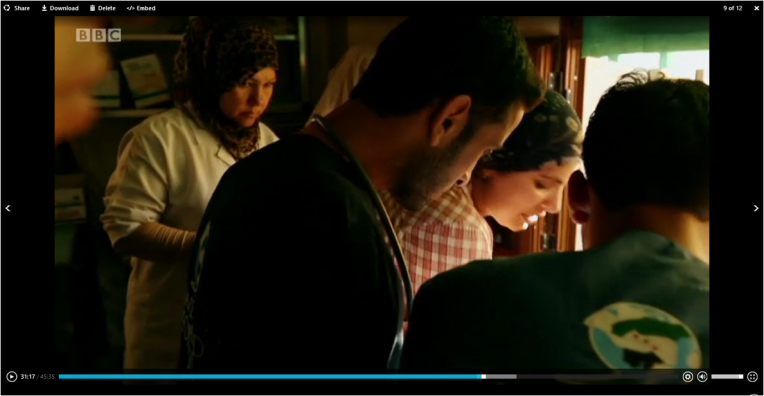
Hand in Hand for Syria nurse (left) next to Dr Saleyha Ahsan (checked shirt), ‘Saving Syria’s Children’ (31:17)

Hand in Hand for Syria nurse (left) next to Dr Saleyha Ahsan (checked shirt, holding infant), ‘Saving Syria’s Children’ (31:17)
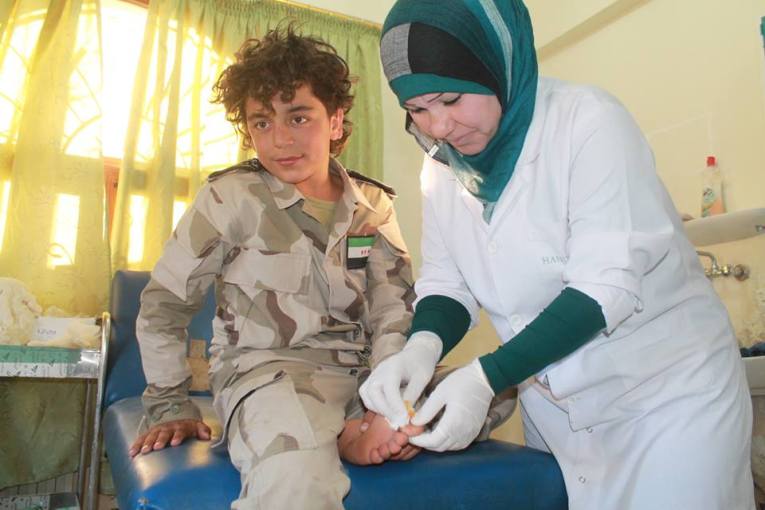
Hand in Hand for Syria nurse apparently treating a child fighter at Atareb Hospital in an image posted on this website http://slnnews.co/?p=2578 in June 2014
[12] The reference is to 37:37 in Saving Syria’s Children where Dr Saleyha Ahsan attempts to insert a cannula into Mohammed Kenas‘ foot, stating “As you can see there’s nothing coming up for me to put a cannula in”.

“Im not sure what A and E that doctor worked in but I have not worked in A and e this year and I have placed I think almost 6 cannulas in peoples feet. Any access is essential in burns, a standard training skill!” – practicing doctor on the efforts of Dr Saleyha Ahsan to insert a cannula at 37:37 in ‘Saving Syria’s Children’
[13] On 18 July 2014 BBC News published a short “retrospective” on the “napalm bomb”. From 32 – 40 seconds the background figures in the hospital, includingLutfi Arsi and the alleged teacher, are heavily blurred.
[14] Note also this portion of the transcription of the younger woman’s words:
… while escaping they called us to return to the school as the war-plane has not finished bombing yet .. they were sure that it will bomb again .. and then the war-plane bombed us .. I did not hear any sound but all what I saw is people burning .. I got burnt and so my friends .. we did not know what happened and why .. a war-plane bombed us and bodies in flames all over the place .. I felt like it is the judgement day.
The highlighted sections are strikingly similar to the words “told” to NBC Chief Foreign Correspondent Richard Engel by a female witness, as reported in this (subsequently deleted) NBC article (note in particular the reference to “Judgement Day”):
A girl who witnessed the attack told NBC News’ Richard Engel that the plane attacked the school twice.
“As we were going inside the classroom, it hit again. I didn’t hear anything. We just saw people burning,” said the student, who was not identified. “My classmates were burning. It felt like Judgment Day.”
This matter is further discussed here.
Note further the reference to the plane attacking the school twice; the BBC andHuman Rights Watch (p13) claim there was one strike on a residential building followed by a second on the school (as indeed does the young woman in the translation above).
[15] After the younger woman in the black dress and blue scarf has finished speaking another young woman appears in this video (at 02:30). She appears unscathed.

[16] Until at least October 2013 the Deputy Commander of the Free Syrian Army was identified as a Colonel Malik al-Kurdi.
[17] On 30 September 2013 Ian Pannell describes Atareb as as a “field hospital”. Dr Hallam also refers to Atareb as a “field hospital” at 38:04 in ‘Saving Syria’s Children’.
[18] The team’s second report detailing local insurgent factions is here.
[19] The BBC now states that Siham Kanbari died on 19 October.
[20] This Human Rights Watch report, which uses the Violations Documentation Center information as the basis for a list of deaths from the “Urm al-Kubra Attack”, states (p20) that “A witness told Human Rights Watch that one of the dead was identified as Mohamad Feda Khenass, 15 years old”.
[21] At some point prior to 8 April 2015 the You Tube channel (“Aleppo and Idleb”) which hosted this video was terminated. Please refer to this copy. The fighter who speaks in the film also appears at 3:25 in this video, hosted by a You Tube channel which has published videos with titles including Captain Abdul Rahman wandering in Daash headquarters of the Abu Bakr al-Ansari and A Daash headquarters in the eastern Ghouta Msraba.
[22] I understand that other videos in the collection contain similar references to a religious teaching centre specifically for females. It is questionable whether it would be likely or indeed permissible for a male teacher to be engaged at a girls’ religious school. The BBC’s reports also feature a male headmaster, named by Dr Ahsan as Mohammed Abu Omar. Both men’s attire would seem to be incongruously casual for staff of a “religious college”.
[23] Other elements in the “Free Halab” videos warrant further scrutiny, for example the plausibility of the claim which I understand is made by the medic interviewed here that he was able to listen to the conversation between the pilot of the MIG and his command centre via a walky-talky.
[24] The Frontline Club states that it’s highly unusual decision not to publish video of an interview with ‘Saving Syria’s Children’” cameraman, director and producer, Darren Conway, in which Conway contradicted his colleague Ian Pannell over the time of the “napalm bomb”, was made in order “to protect those colleagues whose names were mentioned that work in extremely dangerous locations”. As noted here the only individual named in reference to Conway’s then most recent work, in Syria, was “Mughi”, or Mughira Al Sharif, who is both listed in the credits of ‘Saving Syria’s Children’ and who, as demonstrated above, openly proclaims pro-opposition sentiments on social media and elsewhere.
[25] On 17 March 2015, within hours of being posted and with only one view, another video (copy here) containing scenes from Saving Syria’s Children was blocked.



